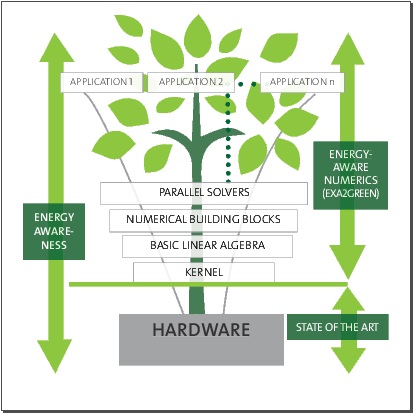Exa2Green FET project: new paradigms for "green" supercomputing

Related topics
Energy ICT Research & Innovation Future and emerging technologies Secure, clean and efficient energy Germany FET Proactive High-Performance-Computingdate: 09/12/2015
Project: Energy-Aware Sustainable Computing on Fu...
acronym: Exa2Green
See also: CORDIS
Identifying the hidden potential
The future advances in HPC technology will keep leading to significant increase in energy consumption. Having recognized that the focus in energy-efficiency development lies in the hardware design, the main objective of the Exa2green project was to investigate the so far unexplored potential to reduce energy use on the level of algorithmic design and software engineering.
The project followed three main lines of activities:
- developing tools for measuring the performance and energy consumption of computations;
- Analyzing existing, widely used computational kernels and developing new energy-efficient algorithms;
- Optimizing a compute-intensive climate model to achieve a considerable reduction of energy consumption in climate simulations. For this research line, Exa2Green used the COSMO-ART - a weather forecast model which has become a standard all over Europe. It served as an example of a computationally (and energy) intensive application.
Software and hardware for green supercomputing
As a result, Exa2green developed software and hardware instruments for high resolution power monitoring. The software tool that allows tracing and analyzing the power and energy consumption of parallel scientific applications will bring benefit to scientists and technicians – they will be able to identify the sources of power inefficiency and optimize the application code. Additionally, the project team has designed a low-cost and accurate measurement device called ArduPower. This internal power meter can be used to examine the energy consumption of scientific applications of HPC infrastructures. Furthermore, Exa2green has created very precise models for characterization and time-energy-power prediction of several elementary computational kernels. Finally, the team members have also optimized the weather forecast software COSMO-ART. By identifying the energy-consumptive components, they were able to tailor the model to be more energy-efficient. It can now perform higher-resolution forecasts over longer periods, while being eco-friendly.
Bringing the know-how to the market
After three years of intense work, the FET project Exa2Green achieved remarkable results. In 2015 the scientists from IBM Zurich Research Laboratory of Exa2green received a Gordon Bell Prize, a highly prestigious award recognizing outstanding development in HPC technology. The outcome of the project opens the door for further development in HPC in an energy-smart manner. Translating this technology into products for the market will be the next step – indeed, the team considers continuing in that direction with a spin-off project for the ArduPower device.
This FET Proactive project, funded under the initiative "Minimising energy consumption of computing to the limit", ran from November 2011 till October 2015, and was coordinated by the University of Heidelberg.
